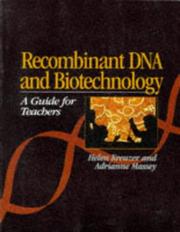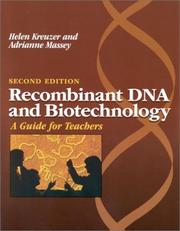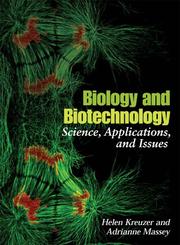| Listing 1 - 8 of 8 |
Sort by
|

ISBN: 1555811019 Year: 1996 Publisher: Washington ASM Press
Abstract | Keywords | Export | Availability | Bookmark
 Loading...
Loading...Choose an application
- Reference Manager
- EndNote
- RefWorks (Direct export to RefWorks)
Recombinant DNA. --- Genetic engineering. --- Biotechnology. --- Recombinant DNA --- Study and teaching --- Biotechnology --- Genetic engineering

ISBN: 1555811752 1555811760 Year: 2001 Publisher: Washington : ASM Press,
Abstract | Keywords | Export | Availability | Bookmark
 Loading...
Loading...Choose an application
- Reference Manager
- EndNote
- RefWorks (Direct export to RefWorks)
Recombinant DNA --- Genetic engineering --- Biotechnology --- ADN recombinant --- Génie génétique --- Biotechnologie --- ADN recombiné --- genetic engineering --- Recombinant-DNA-techniek --- Recombinant - DNA - techniek --- Biotechnology. --- Genetic engineering. --- Recombinant DNA. --- Génie génétique --- rDNA --- DNA --- Genetic recombination --- Genetic vectors --- Designed genetic change --- Engineering, Genetic --- Gene splicing --- Genetic intervention --- Genetic surgery --- Transgenic organisms --- Chemical engineering
Book
Abstract | Keywords | Export | Availability | Bookmark
 Loading...
Loading...Choose an application
- Reference Manager
- EndNote
- RefWorks (Direct export to RefWorks)

ISBN: 9781555814724 Year: 2008 Publisher: Washington : ASM Press,
Abstract | Keywords | Export | Availability | Bookmark
 Loading...
Loading...Choose an application
- Reference Manager
- EndNote
- RefWorks (Direct export to RefWorks)
Molecular biology --- cell structure --- cytology --- genetic engineering --- Animal biotechnology --- Plant biotechnology --- Biotechnology --- DNA, Recombinant --- Genetic engineering --- Genetics --- Methods

ISBN: 9781555814717 Year: 2008 Publisher: Washington : ASM Press,
Abstract | Keywords | Export | Availability | Bookmark
 Loading...
Loading...Choose an application
- Reference Manager
- EndNote
- RefWorks (Direct export to RefWorks)
Molecular biology. --- Animal biotechnology --- cell structure --- cytology --- genetic engineering --- Molecular biology --- Plant biotechnology --- Biotechnology

ISBN: 1555813046 Year: 2005 Publisher: Washington : ASM Press,
Abstract | Keywords | Export | Availability | Bookmark
 Loading...
Loading...Choose an application
- Reference Manager
- EndNote
- RefWorks (Direct export to RefWorks)
sciences --- technological changes --- socioeconomic environment --- cells --- Germplasm --- biology --- ecosystems --- Interdisciplinary research --- industry --- Sustainable development
Book
ISBN: 9781603272193 Year: 2012 Publisher: New York NY Springer New York
Abstract | Keywords | Export | Availability | Bookmark
 Loading...
Loading...Choose an application
- Reference Manager
- EndNote
- RefWorks (Direct export to RefWorks)
Combining the disciplines of biological, physical and chemical science, microbial forensics has a rapidly rising profile in a world increasingly troubled by the threat of biocrime' and bioterrorism'. This valuable resource is a major addition to a body of literature reckoned to lack sufficient breadth. It presents a variety of phenotypic and trace signature methodologies associated with cultured microorganisms that, despite being genetically identical, may be characterized by differing cultural environments. One of the central challenges faced by those working in this field is the sheer diversity of potentially harmful agents, which in themselves total more than 1000 viruses, bacteria, fungi and protozoan parasites. Their numerous additional variants render the process of fingerprinting' biological agents notoriously difficult, especially when the limitations of genetic analysis are factored in. Attribution of crime is relatively easy through human DNA, but lacking the genetic individuation of humans and animals, microbial forensics has to complement phylogenetic techniques with chemical and physical ones. In the best case, genetic analysis in the biocrime' sector can exclude sources, narrow the population of possible sources and support associations with potential sources. To complement these genetic techniques, chemical and physical methods can be used to compare signatures' imparted to microbial samples by environments in which they are grown and processed. Collating a range of microbiological fingerprinting techniques in one volume, and covering everything from statistical analysis to laboratory protocols, this publication furthers the aim of forensic investigators who need robust and legally admissible forensic evidence to present in a courtroom.
General microbiology --- Histology. Cytology --- Medical microbiology, virology, parasitology --- microbiologie --- virologie --- bacteriologie
Digital
ISBN: 9781603272193 Year: 2012 Publisher: New York, NY Springer New York
Abstract | Keywords | Export | Availability | Bookmark
 Loading...
Loading...Choose an application
- Reference Manager
- EndNote
- RefWorks (Direct export to RefWorks)
General microbiology --- Histology. Cytology --- Medical microbiology, virology, parasitology --- microbiologie --- virologie --- bacteriologie
| Listing 1 - 8 of 8 |
Sort by
|

 Search
Search Feedback
Feedback About UniCat
About UniCat  Help
Help News
News